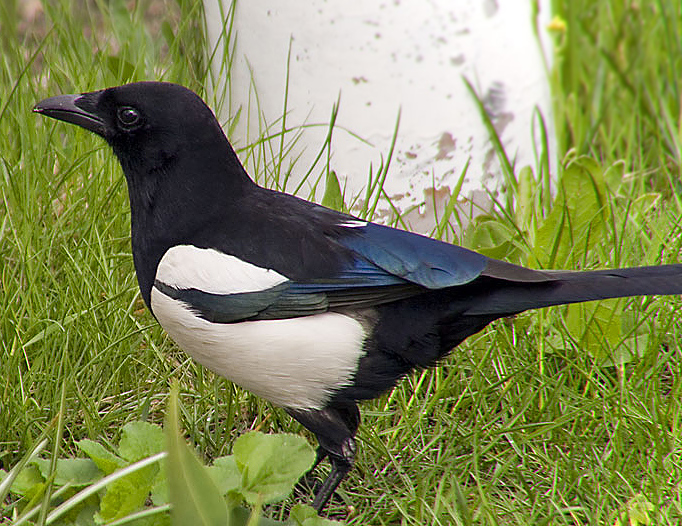|
| Query: Corvidae | Result: 187th of 190 | |
European Magpie (Pica pica) - Wiki
| Subject: | European Magpie (Pica pica) - Wiki
| |

| Resolution: 682x526
File Size: 354407 Bytes
Upload Date: 2007:11:15 16:11:27
|
European Magpie
From Wikipedia, the free encyclopedia
Order: Passeriformes
Family: Corvidae
[Photo] European Magpie (Pica pica). Author: http://commons.wikimedia.org/wiki/User:Skarabeusz
The European Magpie (Pica pica) is a resident breeding bird throughout Europe, much of Asia, and northwest Africa. It is one of several birds in the crow family named as magpies, and belongs to the Holarctic radiation of "monochrome" magpies.
In Europe, "Magpie" is used by English speakers as a synonym for the European Magpie; it is the only magpie in Europe outside the Iberian Peninsula.
Description and systematics
The European Magpie is 40???51 cm in length. Its head, neck and breast are glossy black with a metallic green and violet sheen; the belly and scapulars (shoulder feathers) are pure white; the wings are black glossed with green or purple, and the primaries have white inner webs, conspicuous when the wing is open. The graduated tail is black, shot with bronze-green and other iridescent colours. The legs and bill are black.
The young resemble the adults, but are at first without much of the gloss on the sooty plumage. The male is slightly larger than the female.
There are numerous subspecies. The northwest African race differs in having a patch of bare skin around the eye and no white patch on the rump, and the southwest Arabian race differs in being smaller, with dull black plumage lacking iridescent tones, and minimal white in the wings. The Siberian races have more extensive white in the wings, and brilliant green iridescence; Korean birds have a purple gloss instead and relatively longer wings and a shorter tail.
Analysis of mtDNA sequences (Lee et al., 2003) has indicated that the Korean race, P. pica sericea, is very distinct from the other Eurasian forms, and may be a separate species. The North American Black-billed Magpie which looks almost identical to the Eurasian form and was previously considered conspecific is genetically closer to the Yellow-billed Magpie. The main Eurasian lineages of this astoundingly variable species have not been sufficiently sampled to clarify the status of such forms as the northwest African race P. p. mauretanica and the southwest Arabian race P. p. asirensis, which could also be distinct species.
A larger palaeosubspecies of the European Magpie was described as Pica pica major.
Ecology and behavior
The strikingly pied plumage and long (20-30cm), graduated tail, as well as its loud, harsh chatter, prevent confusion with any other species. In the open country the Magpie commands attention as one, two, three or more birds, with rapidly moving, apparently short wings, fly in succession, chattering as they pass. When the bird alights the long tail is at once elevated and is carefully carried clear of the ground.
Like other corvids, such as crows, the Magpie's usual gait is a walk, but when attracted by food or any special object it hops quickly sideways with wings just open. The fondness of all its family for bright objects is well known.
No animal food comes amiss to the Magpie; young birds and eggs, small mammals and insects are devoured, but acorns, grain and other vegetable substances are not despised.
In country areas the bird, owing to persecution, is often shy, but in suburban areas it is common. Indeed, where it is not molested it courts rather than avoids the vicinity of humans. Also, it is known to team up in bands of two or more to "tease" cats, i.e. launch feigned attacks on the animals, perhaps as a general reaction against the cat as predator and egg thief.
In winter the Magpie becomes gregarious, wandering and feeding in small parties or flocks, and gathering at a common rendezvous to roost at night. Early in the year large numbers collect together for mating. Charles Darwin refers to these congregations as "marriage meetings".
The magpie has been observed taking small songbirds down, in flight, a behaviour once reserved only for birds of prey.
Reproduction
In the courtship display, the males rapidly raise and depress their head feathers, uplift, open and close their tails like fans, and call in soft tones quite distinct from their usual chatter. In the display the loose feathers of the flanks are brought over and the primaries, and the patch on the shoulders is spread so as to make the white conspicuous, presumably to attract the female eye. Short buoyant flights and chases are part of the courtship.
Tall trees are selected by the Magpie for its bulky nest; it is firmly attached to a central fork in the upper branches. The framework of the sticks is cemented with earth and clay. and a lining of the same material is covered with fine roots; above is a stout, though loosely, built dome of prickly branches with one well-concealed entrance. When the leaves fall these huge nests are plainly visible. Where trees are scarce, and even in well-wooded country, nests are at times built in bushes and hedgerows.
The eggs, small for the size of the bird, number from five to eight, and as many as ten are recorded; they show much variation in ground and marking, but a usual type is blue-green with close specks and spots of brown and grey. They are laid in April, and only one brood is reared unless disaster overtakes the first clutch.
...
http://en.wikipedia.org/wiki/European_Magpie
| The text in this page is based on the copyrighted Wikipedia article shown in above URL. It is used under the GNU Free Documentation License. You may redistribute it, verbatim or modified, providing that you comply with the terms of the GFDL. |
|
Comments |
|---|
| | Guest |
|
| whats up people |
^o^
Animal Pictures Archive for smart phones
^o^
|
|
|